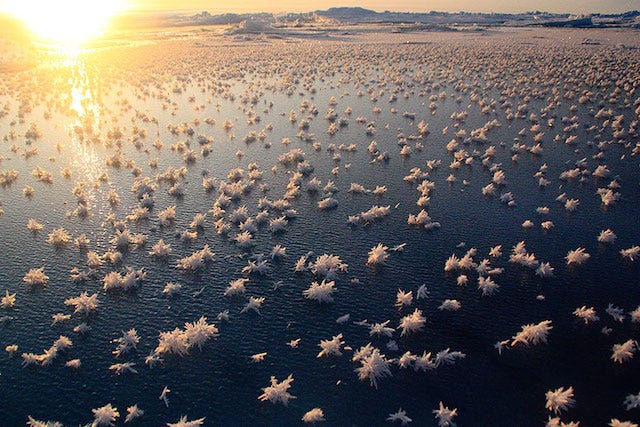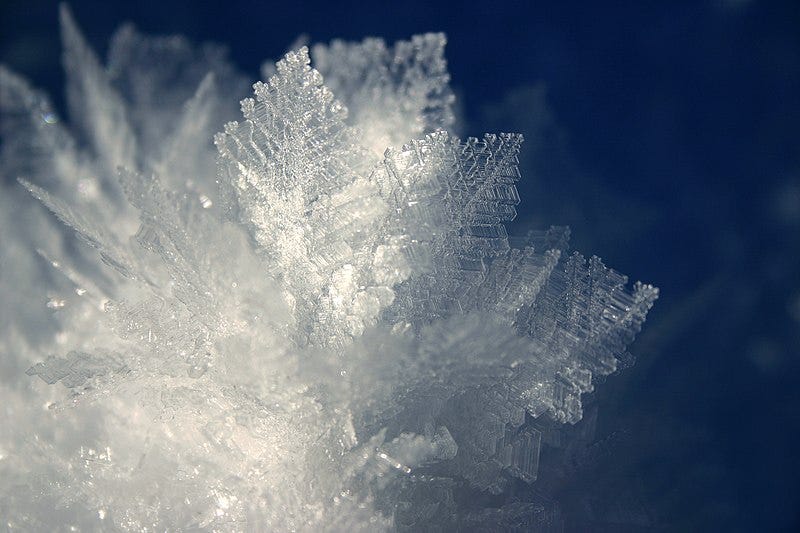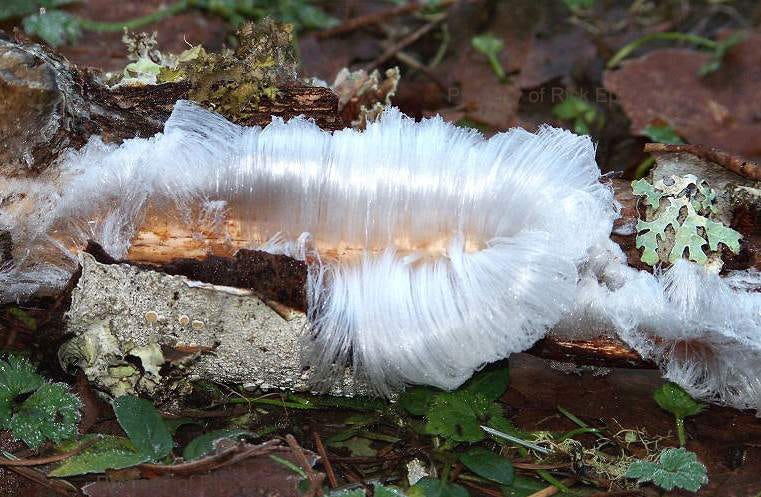Hello! This is Everything Is Amazing, a newsletter about science, curiosity and thousands of invisible hands.
It’s been a while since I was interviewed, so I was delighted to go on my friend Pam’s terrific new podcast. It’s all about getting sacked - and I talked about getting the boot from the second-best writing job I’ve ever had:
If you’ve ever wondered what it takes to get fired from one of the hottest platforms on the internet, have a listen here.
(Pam’s a great interviewer - and she’s looking for other stories about getting fired, so if you have one, click ye here.)
OK! Today, we’re returning to the sky sciences (the main topic for this season) - and we start with something very odd in the Arctic Ocean.
On September 2nd, 2009, just after 4am, oceanography grad student Jeff Bowman steps onto the deck of the ship carrying him away from the North Pole, and sees this:
As you can see in this photo taken by his colleague and shipmate Matthias Weitz … well, what can you see?
As Jeff said to NPR’s Robert Krulwich, it was like “a meadow spreading off in all directions” - and it was growing right before his eyes.
The unsurprising nickname given to these short-lived natural sculptures is ice flowers. They’re currently rare, and they’re what happens when the air above the sea is around 20°C colder than the surface of it, and also a lot drier. As new ice forms at the boundary between sea and air, it performs one of water’s weirdest physical tricks - turning from its solid state to its gaseous form without becoming liquid, better known as sublimation.
That moist air, heavy with sublimed vapour, rises off the sea into that dry & bitterly cold layer of air above it - and instantly becomes supersaturated, and forced to dump its moisture. (This is the mechanism behind cloudbursts, when the sky seems to violently blast all its rain down upon you all at once, with a roar you can feel in your knees).
Triggered by every tiny protrusion of ice that lifts itself high enough, that airborne moisture freezes onto it (nucleation) to create intricate static explosions of hoar-frost, the kind you’ll see in the still-shadowed parts of your lawn after a really cold night - but in this case, the frost ‘grows’ upwards and outwards, like the branches of a tree, according to all the beautiful fractal traces of nature’s workings that you can see in a snowflake.
Were you to successfully scoop up an ice flower - which is unlikely, since they’re incredibly fragile, but let’s just say you did - and popped it into your mouth, you’d find it disgustingly, heart-palpitatingly salty. For complicated reasons, the top of sea ice is usually slicked with a layer of brine, and ice flowers wick that saltiness upwards over their deep-frozen ‘petals’ (or maybe ‘skeleton’ is closer, even if it ruins the analogy).
Yet somehow, these tiny blooms of ice hold life. This isn’t just surprising because of the cold - the high salinity should be killing everything off, according to conventional wisdom about such things. But recent research elsewhere has show microbes thriving in seemingly lethally salty water in industrial ponds in Southern California.
Salt, it seems, is not the barrier to life it was once thought to be - and the bacteria making a home in frost flowers (up to a million of them) are another example of it…
Okay. Why should you care about all this?
Well, for starters, it’s life, and life transforms everything it touches. Considering the other dramatic changes currently underway in our polar regions, and the importance of ice in regulating the temperature of our world, it’s important to know how microbial life can affect things - particularly since it seems likely that as the ice sheets retreat further and further, ice flowers should become a much more common sight.
Secondly, an ice flower is a collaboration between a cooled version of the air you have in your lungs every second of every day of your life, and the roughly 60% of your body that’s made of water (plus the 0.4% that’s salt). In this sense, we are made of the stuff of ice flowers, even thought it’s existing within us in an entirely different state. I’d say that’s grounds for being just a little curious?
(And also: you should care if you care, even if you don’t know why you care, and that caring should feel like it’s enough of an explanation in itself. If wild animals like to have fun for no reason, why can’t we bring ourselves to do the same?! Okay okay, I keep banging this drum, yes. Onwards.)
All this got me thinking, up here in Scotland at the coldest time of the year - surely that’s as bizarre as ice gets?
Here are three examples of how wrong I was.
1. OH WOW YOU’RE SO HAIRY!!!
Garden designer extraordinaire
recently tagged me on Substack Notes (along with nature writer ) to ask me what she was looking at:At the time I had no idea. I do now - it’s needle ice, caused by water under the ground being drawn up through capillary action and freezing on contact with sub-zero-temperature air.
But it did remind me of this:
This may look like a deep-frozen toupée, hence its name, hair ice - but it’s actually due to a specific kind of fungus (Exidiopsis effusa) that grows on rotten wood. Via a process called ice segregation [PDF], the ice is extruded into these long, thin and incredibly fragile hairs, and then the fungus chemically stabilizes them with something akin to the proteins in antifreeze.
(Its discovery is credited to German climatologist Alfred Wegener, who also originated the hypothesis of continental drift, laying the groundwork for plate tectonics - but Exidiopsis effusa’s role in hair ice formation was only discovered in 2015.)
2. OMG RACISTS!!!
Despite looking like a national meeting of the Klan, penitentes are blades of hardened snow that point towards the sun, formed from irregular surfaces of snow subliming at different rates.
The name comes from their similarity to the pointed habits and hoods of brothers of religious orders in the Processions of Penance during Spanish Holy Week - and the first recorded sighting of them was by Charles Darwin in 1839, making his way between from Santiago de Chile to Mendoza, Argentina.
While the ones on our planet range between 5cm and 5 metres tall, it’s possible that Jupiter’s moon Europa may be bristling with 15-metre-tall versions of them (although there is some debate about how feasible this is). If they do exist, it could make landing on Europa a really tricky prospect.
3. WAIT, THAT’S…AN AIRCRAFT CARRIER?!?
During the Second World War, British inventor Geoffrey Pyke approach Chief Of Combined Operations Lord Mountbatten with a daring new plan for foiling attacks from German U-boats in the Atlantic.
At 600 metres (1,969 ft) long, it would be the largest navy vessel ever constructed, and the longest ship ever to set sail. (By comparison, RMS Titanic was 269 metres from end to end - and the longest ship in the world to this day is the Seawise Giant at 458.45 m, about as long as the Empire State Building is tall.)
How could such a colossal monster of a thing set sail? How would it float? Simple! It would be built of reinforced ice. Or rather, a composite of 86% ice and 14% sawdust which Pyke dubbed “pykrete”. In essence, they would create an iceberg shaped like an aircraft carrier.
Midway through development, it became clear that pykrete has a structural flaw that perhaps wouldn’t be the best thing to encounter in the middle of the Atlantic:
“…ice flows slowly, in what is known as plastic flow, and his tests showed that a pykrete ship would slowly sag unless it was cooled to −16 °C (3 °F).”
(via Wikipedia)
Despite pykrete proving much tougher than normal ice - as proven by Mountbatten firing his service revolver into a block of it and almost killing a nearby Admiral with the ricochet - a prototype built in 1944 confirmed predictions that a full-size vessel would cost more money and machinery than a fleet of conventional aircraft carriers and would destroy Britain’s paper industry with the amount of wood pulp required.
The project was abandoned - until 2009, when an episode of Mythbusters re-tested the principle using ice and sheets of newspaper to build a small flat-bottomed boat.
Their eventual verdict: “Plausible, but ludicrous.”
BONUS WEIRD ICE: Snow Rollers!
Images: Matthias Weitz; Annick MONNIER/Wikimedia; European Southern Observatory/Wikimedia; Vielfalt/Wikimedia; Jasonpettit/Wikimedia; Rick Eppler.











I've looked at ice from both sides now. Hairy ice - I rather thought that it was a small - is there any other kind ? - Shih Tzu in cryonic suspension. Or a caterpillar. 😆🐛 I'll never see gelato or frozen yogurt in quite the same way again. Kudos, Mike !
Cool stuff. No pun intended.